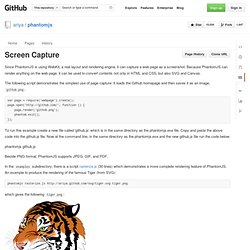

How to lose weight (in the browser) Marathia Stacks. How to automatically post links to your latest blog articles on social media websites - realmacsoftware. A place for customers to chat about Realmac and its products - RapidWeaver, Clear and Ember!

Hello, This is something I was asked about by a client a few weeks ago, and I decided to writeup my findings and present this information as a 'how to' for other RapidWeaver users: This is useful if you maintain a blog via RapidWeaver or another publishing platform. A free service like TwitterFeed monitors your blog RSS feed for new articles. When new articles are published, TwitterFeed publishes the blog entry title and link to your Twitter, Facebook, LinkedIn or App.net account automatically. It serves as a useful method to promote your blog. CasperJS, a navigation scripting and testing utility for PhantomJS. Screen Capture · ariya/phantomjs Wiki. Since PhantomJS is using WebKit, a real layout and rendering engine, it can capture a web page as a screenshot.

Because PhantomJS can render anything on the web page, it can be used to convert contents not only in HTML and CSS, but also SVG and Canvas. The following script demonstrates the simplest use of page capture. It loads the Github homepage and then saves it as an image, github.png. var page = require('webpage').create(); page.open(' function () { page.render('github.png'); phantom.exit(); }); To run this example create a new file called 'github.js' which is in the same directory as the phantomjs.exe file. Phantomjs github.js Beside PNG format, PhantomJS supports JPEG, GIF, and PDF. In the examples subdirectory, there is a script rasterize.js (30 lines) which demonstrates a more complete rendering feature of PhantomJS. Phantomjs rasterize.js tiger.png which gives the following tiger.png: Another example is to show polar clock (from RaphaelJS): jQuery Cheat Sheet. Selectors #id, HTML tag, .class $(‘#myID’);, $(‘body’);, $(‘.myClass’); This is similar to regular CSS selectors. elem1, elem2, elem3 $(‘#myID, p, .myClass’); Multiple elements being selected at once. ancestor descendant $(‘#myID .IDsChildren’); This is similar to regular CSS selectors.

Parent > child $(‘body > #content’); Here we are selecting all #content that is only one level deep from the body tag. prev + next $(‘#myID + ul’); Selects the ul that immediately precedes #myID prev ~ siblings $(‘#myID ~ ul’); :first or :last $(‘ul li:first’); Selects the first li within any ul. :not(?) $(‘ul *:not(li)’); Selects all elements that is has ul as a parent and is not an li. :even or :odd $(‘ul li:even’); Selects all li that are an even.